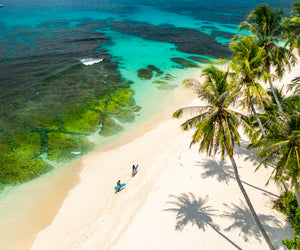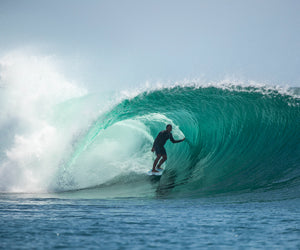
The Drifter Journals
Gyotaku - First Impressions
Desmond Thain paws meticulously over the bare, black outlines upon the large sheet of handmade washi paper in front of him.
A dab of colour here, a skeric of paint there, it is a project that might immerse him for hundreds of hours before he is satisfied with the photo-realistic final product

Born and raised between Japan and the Hawaiian island of Oahu, the ocean was an omnipresent influence upon Desmond’s formative years. Gravitating to all things aquatic, splashing and swimming turned to diving and fishing, harvesting the ocean’s bounty for fun, but also as a means to supplement his household foodstocks.
“Growing up in Hawai'i,” Desmond recalls, “all my uncles, all my friends and family were related to some form of fishing, be it shore casting, trawling or whatever.
“I was thrown into the ocean by my dad. At the beach we would see lots of fish, so we got into fishing. We would never buy our bait and we would go out with a three-prong [spear] to catch tako or octopus.”
Both Hawaiian and Japanese cultures possess a certain reverence for the ocean and its inhabitants, a degree of connection and symbiosis not really found in many Western cultures. Centuries ago, back in the 1800s, Japanese fishermen began to record their catch by coating it in ink and pressing it onto paper. This technique was known as gyotaku, roughly translates as ‘fish impression’.

This documentation was a source of pride for fishermen, while also creating a register of fish caught in local waters. It is rumoured that Samurai would settle fishing competitions with their gyotaku artwork, and prints can still be seen today hanging in coastal fishing shops in Japan.
With Hawai'i's strong Japanese influence and similar oceanic devotion, it is little wonder that, when Desmond progressed to spearfishing, the term gyotaku entered is consciousness:
“As I got older,” says Desmond, “my friends were also spear fishermen, and they would say to me, 'hey Des, you need to gyotaku your fish, you need to fish-print it'.
“At the time, I never really knew what it was - it was just a rudimentary fish drawing to me.”
Fishing - especially spearfishing - is like surfing: there are those moments when the elements align - the ocean is warm and clear, the wind is little more than a breath, you are in the right place and the right time to create a lifelong memory. For Desmond, one such moment occurred that sparked something within, a profound realisation of the beauty of his catch, and the necessity to preserve that beauty.
“One day, I caught a really big kumu, or white-saddle goatfish, and I thought it was the most special thing in my life. I had it in the freezer for two months, and every weekend I'd take it out and look at it, and thought, 'I have to fish-print this'.”

With a little bit of investigation, Desmond managed to locate a handful of local gyotaku artists. However, gyotaku has many forms, numerously interpreted by the creators to convey their own expression of the medium. Though they may well have been highly talented artists, these local gyotaku experts didn’t represent the fish in the way Desmond had envisioned. Acutely aware of the finite details - every scale, every line, the glimmer of the skin in the dappled sun rays as they pour and refract through the ocean’s surface - Desmond realised that, if he was going to truly honour his catch, he would have to do it himself.
“I gave it a shot myself. I went to the craft store, bought some paper and ink and learned the initial printing process through trial and error.
“Next thing I knew, I had friends asking me [for commissioned pieces] and my cousins asking for gifts... it all started from there.”
Kismet is often our most powerful storyteller. Those moments that simply fall at our feet, the chancest union of unintended circumstances, offer the most astounding, life-changing opportunities.
Desmond’s catch had inspired him. His intention was no more than to preserve the awe-inspiring beauty of his quarry, but no photo, no print, no gyotaku available could - in his eyes - do it justice… so he’d just have to do it himself. And so began the career for which he has become world-renowned.
Desmond views gyotaku as a two-stage process. Traditionally, fish were coated in soot or ash-based sumi ink and pressed onto natural-fibre washi paper, the resulting images were little more than a charcoal rubbing, a two-dimensional, monochromatic, fossilised representation of the fish’s former splendour. This classic gyotaku method was just the beginning for Desmond.

“There's many different styles, different ways of doing it,” he says. “However, I'm a very detail-oriented person when it comes to painting. I like to make my artwork look as realistic as possible.”
This photo-realistic approach goes beyond the acute detail, precise brushwork and true-to-life colour. To resolve the image simply by adding some paint would be somewhat of a half measure for Desmond’s desire for precision and verbatim reflection of a living creature.
Talking to his clients, sometimes for hours on end, he not only offers insight into this artistic methodology and its centuries of history, he also learns how and where the fish was caught, encapsulating the memory comprehensively, to the point of mimicking the fish’s last actions and even its last meal, sometimes incorporating schools of smaller fish or crustacea into his artwork to complete the scene.
“Once I get all the conditions perfect, I prop the fins up and I position the mouth or the head to how the fisherman remembers it,” Desmond explains. “Say, for example, the fisherman caught it on some shrimp; I will position it as if it was swimming up with the mouth open, and position it to where it looks anatomically correct.”
This almost obsessive attention to detail and nuance has set Desmond apart, and his artwork is celebrated around the world, for its realism, its creator’s talent, but also its faithfulness to the fish’s last moments and the centuries-old tradition of gyotaku.

This prodigious nod to the history of the genre expands beyond his own canvas. Just like his forebears, for Desmond the art is about the preservation of the moment and the creature. It has become his livelihood, but so too has he remained faithful to the technique’s original intent, and he regularly hosts workshops to both share the joy of printing an often hard-earned catch and sustain the practice of gyotaku for years, and generations, to come.

View more of Desmond Thain’s incredible gyotaku artwork in our online gallery now - available for purchase and international shipping upon request.




